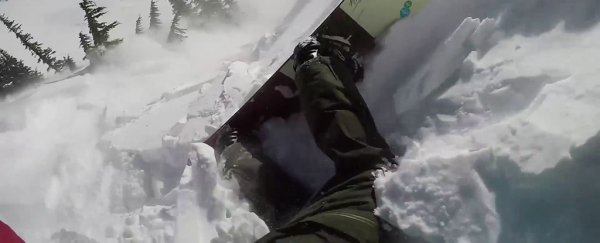There aren't too many skiers and snowboarders who get hit by an avalanche and live to tell the tale, which is why this video footage from Australian snowboarder Tom Oye is such a dramatic watch.
Oye was snowboarding in Whistler, Canada, when the snow beneath his feet began to give way. Whatever action cam he had strapped to his helmet captured the whole scene as he started accelerating down the hill.
Warning: explicit language ahead.
Fortunately, Oye had an inflatable avalanche backpack on his back, which could very well have saved his life – its fan is the strange whirring sound you can hear in the background of the clip and you can see how it keeps the boarder on top of the snow.
"Not how I planned on starting the morning," wrote Oye on Facebook.
Most avalanche deaths are caused by people being completely buried by the onrushing snow, so staying on the surface is essential – especially because it means you're easier to find. After an hour has passed, only one in three of those hit by an avalanche are found alive.
That's why avalanche backpacks and beacons are such a good idea for winter sports enthusiasts, especially those who like to go off-piste, where routes aren't regularly monitored and managed.
You can tell from the audio just how relieved Oye is to survive his ordeal.
By the way, you should watch to the very end of the clip – as the guy coming in on the snowmobile adds some light comic relief to what is a very serious incident.
As we explained when a similar incident was captured on camera a couple of years ago, the science behind avalanches is pretty simple: there's a build-up of too much snow on too steep of a slope.
How much snow is needed to tip the balance depends on the current temperature and humidity, the density of the snow, and several other factors. It's partly to do to with the snowpack, or the layers of different snow types, that have built up.
Take a scenario where there's a repeated cycle of thawing and freezing: that can cause pockets of space inside the snowpack, which makes it more unstable.
Once a slip is triggered, gravity takes over, and the snow will zoom down the mountainside until it finds a new resting place. Landslides happen in much the same way, with mud and rock instead of snow.
We're just happy that Tom Oye lived to tell the tale and upload the whole thing to Facebook. However, it's a sobering thought that in 90 percent of avalanche accidents, the trigger is a snowboarder or skier, as seems to have been the case here.
Stay safe on those backcountry routes, everyone – and always be prepared.
